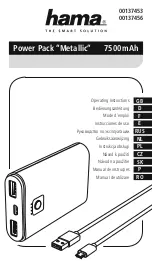
11
Parts & Service: 020 8988 7400 / E-mail: [email protected] or [email protected]
OPERATING HINTS
• Before you sharpen the chainsaw chain check it for damage, such as:
- bent or abraded chain links.
- broken cutting teeth, loose rivets or broken rivet heads.
If any damage is found, replace the entire chain.
• A sharp chainsaw produces
wood chips and pulls itself into
the timber being cut. When it
becomes blunt, sawdust will
start being produced during
cutting operations.
• You should sharpen the chain if
you notice that you have to use
force to cut through the timber,
i.e. if the saw does not “pull”
anymore.
• Sharpen all cutting teeth as uniformly as possible. This will ensure smooth
operation with a minimum of vibration.
• Blunt cutting teeth or parts damaged by stones may cause an inclined
cut during chain saw operation, and may also increase the wear on the
running face of the cutting teeth.
• The depth limiter bars must be
profiled by hand. Ensure that all
depth limiter bars are equal in
height.
• Ensure that all cutting teeth are
sharpened to the same cutting
angle.
• During sharpening occasionally
check that the cutting-angle is
set correctly, as this setting may
go out of adjustment due to
vibration.
• Make sure that all teeth are
sharpened as evenly as
possible. Only sharpen the
teeth, never sharpen the chain
links.
Summary of Contents for ECSS2
Page 17: ......



































